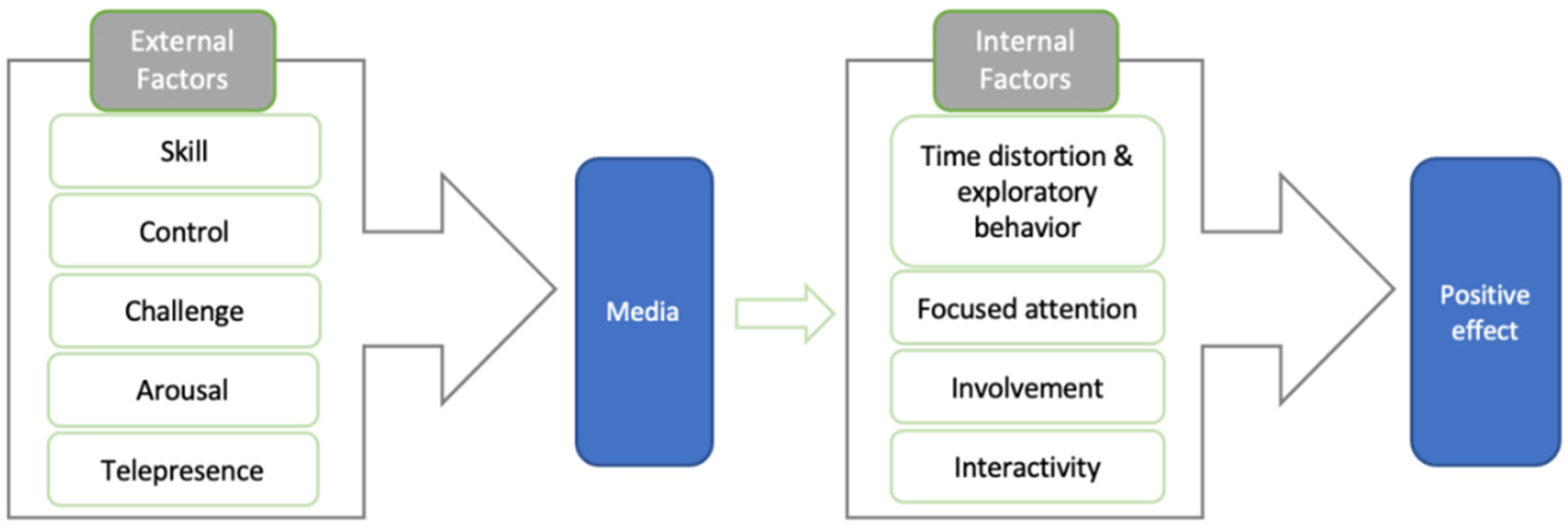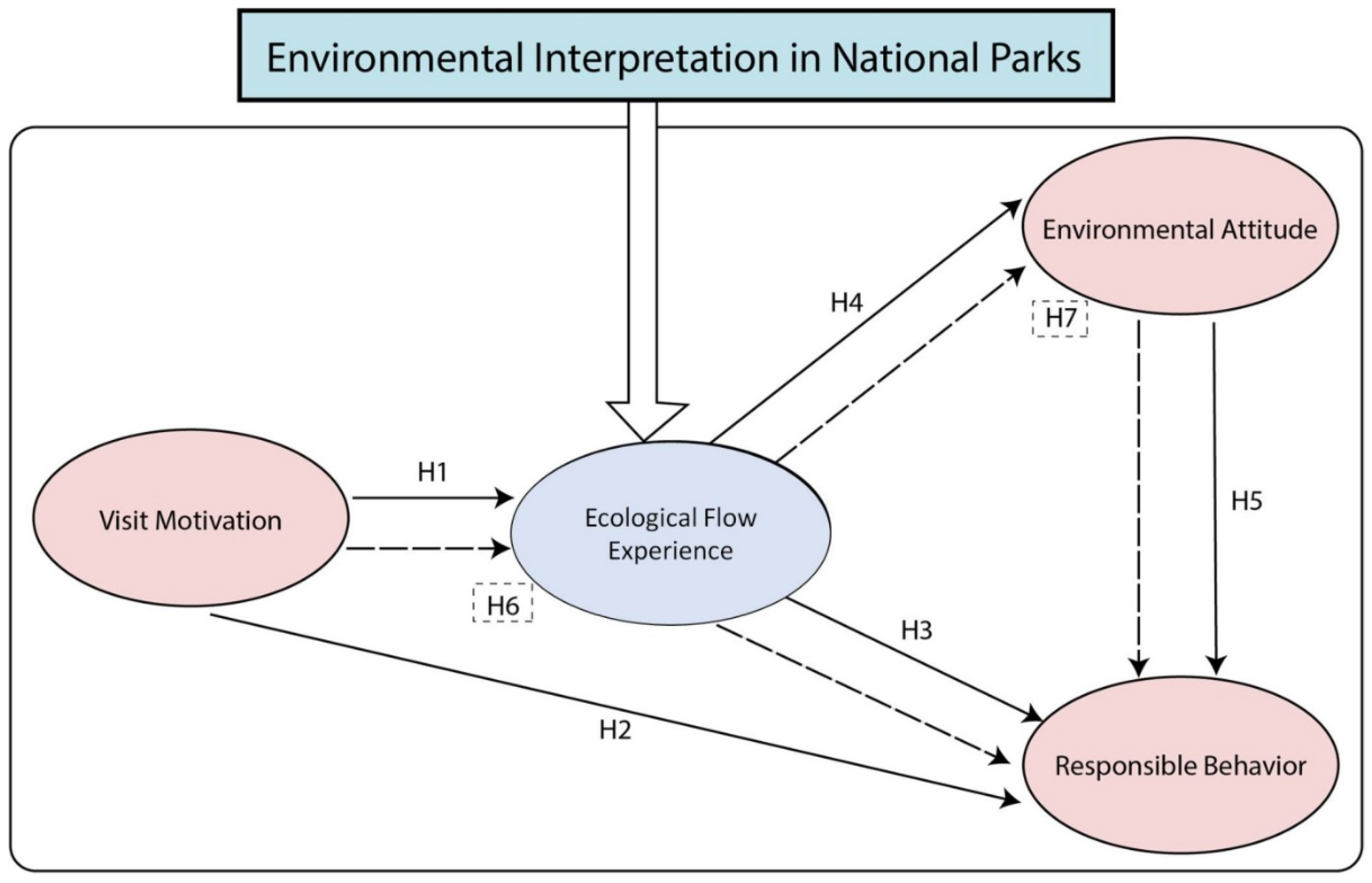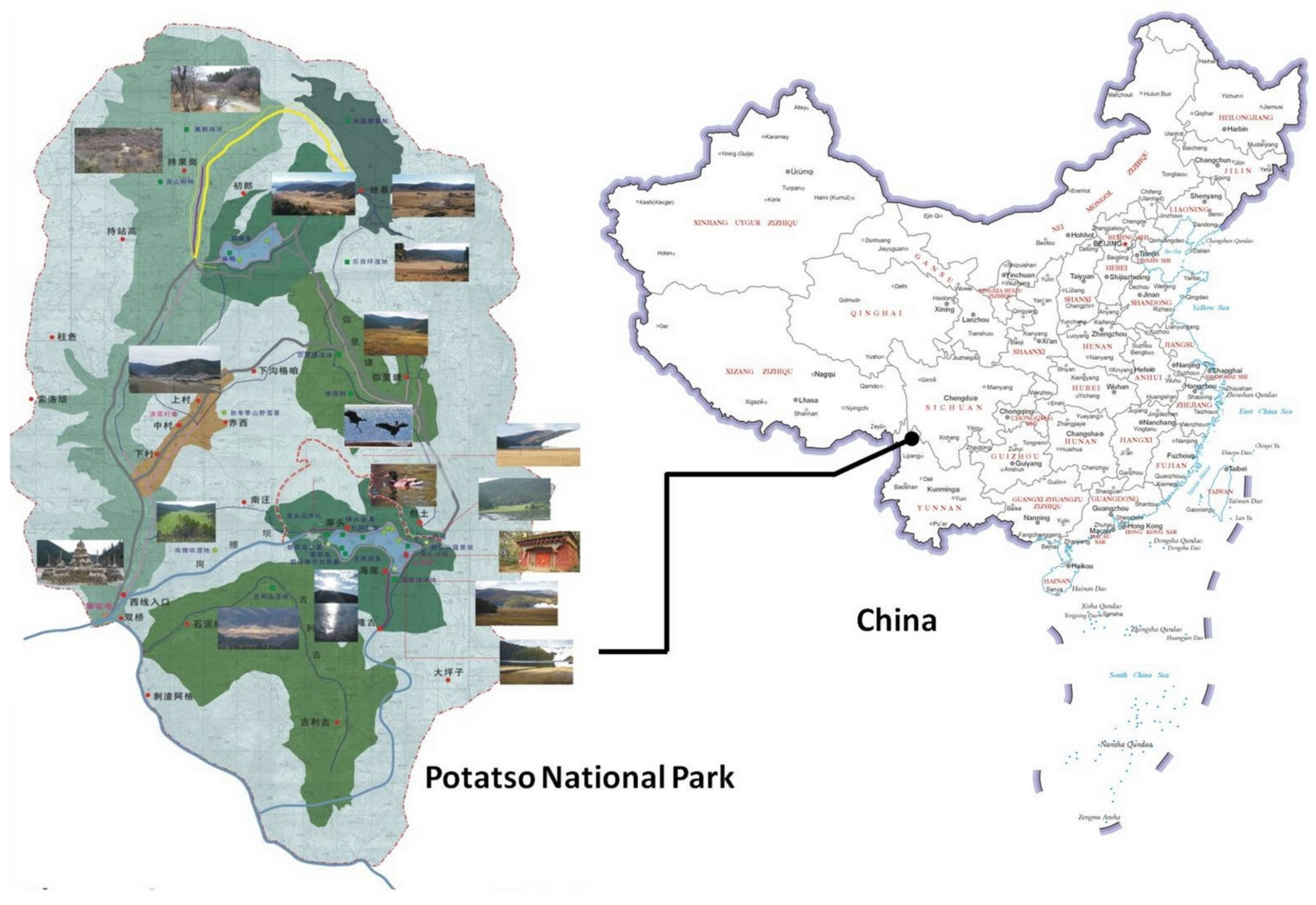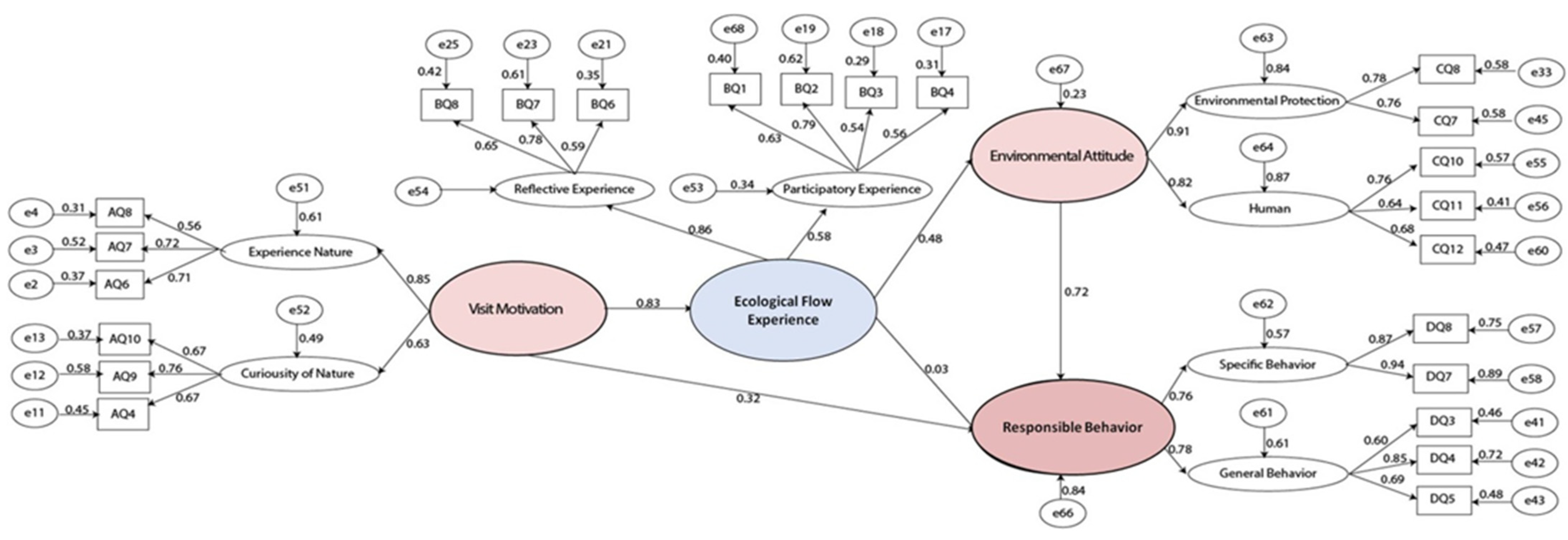Does Environmental Interpretation Impact Public Ecological Flow Experience and Responsible Behavior? A Case Study of Potatso National Park, China
Abstract
1. Introduction
2. Research Review and Model Construction
2.1. Flow Theory
2.2. Hypothesis
2.2.1. Visit Motivation Enhances the Validity of Environmental Interpretation
2.2.2. Environmental Interpretation Promotes the Ecological Flow Experience
2.2.3. Ecological Flow Experience Improves Environmental Attitude
2.2.4. Environmental Attitude Promotes Responsible Behavior
2.2.5. Ecological Flow Experience Mediates Motivation, Attitude, and Behavior
2.3. Conceptual Structure Model
3. Research Methods
3.1. Case Study
3.2. Questionnaire Design and Distribution
3.3. Data Collection
4. Research Result and Analysis
4.1. Reliability and Validity Analysis
4.1.1. Reliability Analysis
4.1.2. Validity Analysis
4.2. Theoretical Hypothesis Verification
4.2.1. Model Fit Test
4.2.2. Direct Effect Test
4.2.3. Mediating Effect Test
5. Discussion and Conclusions
5.1. Discussion
5.2. Limitation
5.3. Conclusions
Author Contributions
Funding
Institutional Review Board Statement
Informed Consent Statement
Data Availability Statement
Acknowledgments
Conflicts of Interest
References
- Tilden, F. Interpreting Our Heritage, 3rd ed.; University of North Carolina: Chapel Hill, NC, USA, 1957. [Google Scholar]
- Zhao, M.Y.; Dong, S.C.; Cui, Q.J.; Li, Z.H.; Vladimiror, I.; Leonid, K.; Zlydneva, I. Construction of environmental interpretation system in national park of China based on natural education function. Environ. Sustain. Dev. 2019, 44, 97–100. [Google Scholar] [CrossRef]
- Guo, H.J.; Ye, W.; Zhao, M.Y.; Wang, X.M. The comparative study of interpretive panels system in Northwest Yunnan protected areas. J. Cent. South Univ. For. Technol. Soc. Sci. 2015, 9, 69–73, 93. [Google Scholar] [CrossRef]
- Xiao, L.L.; Zhong, L.S.; Zhou, R.; Yu, H. Review of international research on national parks as an evolving knowledge domain in recent 30 years. Prog. Geogr. 2017, 36, 244–255. [Google Scholar] [CrossRef][Green Version]
- Song, Q. An empirical study on the recreation motive and influencing factors of the urban residents. Soft Sci. 2008, 22, 22–26. [Google Scholar] [CrossRef]
- Csikszentmihalyi, M. Finding Flow: The Psychology of Engagement with Everyday Life; Basic Books: New York, NY, USA, 1997. [Google Scholar]
- Csikszentmihalyi, M. Beyond boredom and anxiety. Contemp. Sociol. 1975, 6, 272. [Google Scholar]
- Czikszentmihalyi, M. Intrinsic motivation and effective teaching: A flow analysis. New Dir. Teach. Learn. 1982, 1982, 15–26. [Google Scholar] [CrossRef]
- Csikszentmihalyi, M. Flow: The Psychology of Optimal Experience; HarperCollins Publishers: New York, NY, USA, 1990. [Google Scholar]
- Zhao, M.Y.; Dong, S.C.; Wu, Z.H.; Li, Y.; Ma, H.; Shao, D.; Gao, N.; Xia, B. Influence of forest experience education on urban public’s environmentally responsible behavior. Resour. Sci. 2020, 42, 583–592. [Google Scholar] [CrossRef]
- Nakamura, J.; Csikszentmihalyi, M. Flow theory and research. In Handbook of Positive Psychology; Oxford University Press: New York, NY, USA, 2009; pp. 194–206. [Google Scholar] [CrossRef]
- Quinn, R.W. Flow in knowledge work: High performance experience in the design of national security technology. Adm. Sci. Q 2005, 50, 610–641. [Google Scholar] [CrossRef]
- Novak, T.P.; Hoffman, D.L.; Duhachek, A. The influence of goal-directed and experiential activities on online flow experiences. J. Consum. Psychol. 2003, 13, 3–16. [Google Scholar] [CrossRef]
- Hamilton, E.; Hurford, A. Combining collaborative workspaces with tablet computing: Research in learner engagement and conditions of flow. In Proceedings of the 2007 37th Annual Frontiers In Education Conference-Global Engineering: Knowledge Without Borders, Opportunities Without Passports, Milwaukee, WI, USA, 10–13 October 2007; pp. T3C–3–T3C–8. [Google Scholar] [CrossRef]
- Spreitzer, G.M.; Quinn, R.E.; Fletcher, J. Excavating the paths of meaning, renewal, and empowerment. J. Manag. Inq. 1995, 4, 16–39. [Google Scholar] [CrossRef]
- Ou, X.F.; Tan, H. Internet product design based on flow theory. Packag. Eng. 2016, 37, 70–74. [Google Scholar]
- He, Q.K.; He, R.K. Interaction design of mobile learning application based on the flow theory. Packag. Eng. 2018, 39, 188–192. [Google Scholar] [CrossRef]
- Tolvanen, A.; Kangas, K.; Tarvainen, O.; Huhta, E.; Jäkäläniemi, A.; Kyttä, M.; Nikula, A.; Nivala, V.; Tuulentie, S.; Tyrväinen, L. The relationship between people’s activities and values with the protection level and biodiversity. Tour. Manag. 2020, 81, 104141. [Google Scholar] [CrossRef]
- Ballantyne, R.; Packer, J.; Sutherland, L.A. Visitors’ memories of wildlife tourism: Implications for the design of powerful interpretive experiences. Tour. Manag. 2011, 32, 770–779. [Google Scholar] [CrossRef]
- Dann, G.M.S. Anomie, ego-enhancement and tourism. Ann. Tour. Res. 1977, 4, 184–194. [Google Scholar] [CrossRef]
- Iso-Ahola, S.E. Basic dimensions of definitions of leisure—Part one. Leis. Sci. 1979, 11, 255–279. [Google Scholar]
- Crompton, J.L. Motivations for pleasure vacation. Ann. Tour. Res. 1979, 6, 408–424. [Google Scholar] [CrossRef]
- Dagustani, D.; Kartini, D.; Oesman, Y.M.; Kaltum, U. Destination image of tourist: Effect of travel motivation and memorable tourism experience. Etikonomi 2018, 17, 307–318. [Google Scholar] [CrossRef]
- Miller, Z.; Taff, B.D.; Newman, P. Visitor experiences of wilderness soundscapes in Denali National Park and Preserve. Int. J. Wilderness 2018, 24, 32–43. [Google Scholar]
- Rybina, L.; Lee, T.J. Traveler motivation and destination loyalty: Visiting sacred places in Central Asia. Tour. Hosp. 2021, 2, 1. [Google Scholar] [CrossRef]
- Zhao, J.; Xuan, G.F.; Zhu, Y. Motivation and behavioral characteristics of the park-based recreation for urban residents in transitional period: A case study of Xuanwu Lake Park in Nanjing. Areal Res. Dev. 2016, 35, 113–118, 133. [Google Scholar] [CrossRef]
- Ballantyne, R.; Packer, J. Using tourism free-choice learning experiences to promote environmentally sustainable behaviour: The role of post-visit ‘action resources’. Environ. Educ. Res. 2011, 17, 201–215. [Google Scholar] [CrossRef]
- Porter, A.L.; Howard, J.L. Warning visitors about the potential dangers of dingoes on Fraser Island, Queensland, Australia. J. Interpret. Res. 2002, 7, 51–63. [Google Scholar] [CrossRef]
- Weiler, B.; Smith, L. Does more interpretation lead to greater outcomes? an assessment of the impacts of multiple layers of interpretation in a zoo context. J. Sustain. Tour. 2009, 17, 91–105. [Google Scholar] [CrossRef]
- Zhou, W. Reviews and prospects on environment education in national park. For. Inventory Plan. 2019, 44, 102–106, 124. [Google Scholar]
- Wu, E.; Cheng, J.Q. The role and significance of environmental interpretation in landscape planning and design. Landsc. Archit. 2019, 26, 54–59. [Google Scholar] [CrossRef]
- Cohen, E. A Phenomenology of tourist experiences. Sociology 1979, 13, 179–201. [Google Scholar] [CrossRef]
- Kim, J.H. The impact of memorable tourism experiences on loyalty behaviors: The mediating effects of destination image and satisfaction. J. Travel Res. 2018, 57, 856–870. [Google Scholar] [CrossRef]
- Hong, X.T.; Zhang, H.M.; Zhang, Y.C. Influence of tourism experience on environmental attitude and behavior: A longitudinal tracking study. J. Nat. Resour. 2018, 33, 1642–1656. [Google Scholar] [CrossRef]
- Hill, R.J.; Fishbein, M.; Ajzen, I. Belief, attitude, intention and behavior: An introduction to theory and research. Contemp. Sociol. 1977, 6, 244–245. [Google Scholar] [CrossRef]
- Asan, I.; Mile, S.; Ibraim, J. Attitudes of macedonian high school students towards the environment. Procedia-Soc. Behav. Sci. 2014, 159, 636–642. [Google Scholar] [CrossRef]
- Wight, A.C.; Lennon, J.J. Selective interpretation and eclectic human heritage in Lithuania. Tour. Manag. 2007, 28, 519–529. [Google Scholar] [CrossRef]
- Walker, K.; Moscardo, G. Moving beyond sense of place to care of place: The role of Indigenous values and interpretation in promoting transformative change in tourists’ place images and personal values. J. Sustain. Tour. 2016, 24, 1243–1261. [Google Scholar] [CrossRef]
- Jacobs, M.H.; Harms, M. Influence of interpretation on conservation intentions of whale tourists. Tour. Manag. 2014, 42, 123–131. [Google Scholar] [CrossRef]
- Kil, N.; Holland, S.M.; Stein, T.V. Structural relationships between environmental attitudes, recreation motivations, and environmentally responsible behaviors. J. Outdoor Recreat. Tour. 2014, 7, 16–25. [Google Scholar] [CrossRef]
- Petric, L.; Mandic, A. Visitor management tools for protected areas focused on sustainable tourism development: The croatian experience. Environ. Eng. Manag. J. 2014, 13, 1483–1495. [Google Scholar] [CrossRef]
- Cook, K.J.; Hvenegaard, G.T.; Halpenny, E.A. Visitor perceptions of the outcomes of personal interpretation in Alberta’s Provincial Parks. Appl. Environ. Educ. Commun. 2019, 20, 49–65. [Google Scholar] [CrossRef]
- Powell, R.B.; Ham, S.H. Can ecotourism interpretation really lead to pro-conservation knowledge, attitudes and behaviour? evidence from the Galapagos Islands. J. Sustain. Tour. 2008, 16, 467–489. [Google Scholar] [CrossRef]
- Chen, K.; Guo, F. Analysis on the mechanism of the psychological factors of green consumption behavior: Based on the perspective of psychological process. Enterp. Econ. 2013, 32, 124–128. [Google Scholar] [CrossRef]
- Yu, K.K.; Zhao, H.B.; Qian, C.; Gao, J. Literature review and meta-analysis of the relationship between environmental attitude and environmental behavior. Res. Environ. Sci. 2018, 31, 1000–1009. [Google Scholar] [CrossRef]
- Schmitz, G.L.; da Rocha, J.B.T. Environmental education program as a tool to improve children’s environmental attitudes and knowledge. Education 2018, 8, 15–20. [Google Scholar] [CrossRef]
- Lee, T.H.; Jan, F.H. The influence of recreation experience and environmental attitude on the environmentally responsible behavior of community-based tourists in Taiwan. J. Sustain. Tour. 2015, 23, 1063–1094. [Google Scholar] [CrossRef]
- Moyle, B.D.; Scherrer, P.; Weiler, B.; Wilson, E.; Caldicott, R.; Nielsen, N. Assessing preferences of potential visitors for nature-based experiences in protected areas. Tour. Manag. 2017, 62, 29–41. [Google Scholar] [CrossRef]
- Sirivongs, K.; Tsuchiya, T. Relationship between local residents’ perceptions, attitudes and participation towards national protected areas: A case study of Phou Khao Khouay National Protected Area, central Lao PDR. For. Policy Econ. 2012, 21, 92–100. [Google Scholar] [CrossRef]
- Jamal, T.; Stronza, A. Collaboration theory and tourism practice in protected areas: Stakeholders, structuring and sustainability. J. Sustain. Tour. 2009, 17, 169–189. [Google Scholar] [CrossRef]
- Wang, L.P.; Tang, X.P.; Tang, X.F. Evaluate environmental education function of national parks: A case study in Pudatsuo National Park. Cult. Geogr. 2016, 22, 116–124. [Google Scholar]
- Zhao, M.Y.; Dong, S.C.; Guo, H.J.; Gao, N.; Li, Y.; Tang, T.T.; Su, T.W. Effects of environmental interpretation service of national park on guiding public’s behavior. J. Arid. Land Resour. Environ. 2019, 33, 202–208. [Google Scholar] [CrossRef]
- Liu, C.A.; Qi, T.; Li, X.Y.; Zhang, G.Q. The Research on Recreation Motivation of Beijing Country Park. J. Cap. Norm. Univ. (Nat. Sci. Ed.) 2016, 1, 83–88. [Google Scholar] [CrossRef]
- Liu, W.F.; Yin, Y.F.; Xiao, B.S. Environmental Attitude and Behavior in Shennonggu National Forest Park. J. Cent. South Univ. For. Sci. Technol. (Soc. Sci.) 2011, 5, 144–146. [Google Scholar] [CrossRef]
- Yu, Y.; Tian, J.X.; Su, J. A Study of the Relativity between Place Attachment and Post-Tour Behavioral Tendencies of Visitors: Taking Value Perception and Satisfaction Experience as Intermediary Variables. Tour. Sci. 2010, 24, 54–62. [Google Scholar] [CrossRef]
- Luo, F.; Zhong, Y.D. Ecotourist Segmentation in Wulingyuan World Heritage Site: A Perspective From Environmental Attitude and Environmental Behavior. Econ. Geogr. 2011, 2, 333–338. [Google Scholar] [CrossRef]
- Li, H.J.; Gan, M.Y.; Pan, H. Research on the relationship between recreational experience and recreational environmental responsibility behavior—Taking Fuzhou National Forest Park as an example. J. Chongqing Univ. Sci. Technol. (Soc. Sci.) 2018, 2, 55–60. [Google Scholar] [CrossRef]
- Dong, X. Research on the Relationship among Tourists’ Environmental Attitude, Tourism Experience and Environmental Responsible Behavior—A case study of Wudang Mountain. Master’s Thesis, Central China Normal University, Wuhan, China, 2018. Available online: https://kns.cnki.net/KCMS/detail/detail.aspx?dbname=CMFD201901&filename=1018234270.nh (accessed on 2 August 2022).




| Reference Author | Reference Choice |
|---|---|
| ZHAO Minyan (2019) [2] | AQ12 Learn about the natural environment |
| AQ15 Socialize | |
| LIU Chuanan (2016) [53] | AQ13 Enhance emotional communication with relatives and friends |
| SONG Qiu (2008) [5] | AQ14 Work requirement |
| LIU Weifeng (2011) [54] | CQ1 More environmental interpretations are important |
| CQ6 Polluting the environment is immoral | |
| CQ8 Biodiversity and wildlife depend on human awareness of environmental protection | |
| DQ1 I am willing to participate in environmental interpretation | |
| DQ7 I will not throw trash in the park | |
| YU Yong (2010) [55] | CQ2 The ecological environment is vulnerable |
| CQ3 Humanity is part of the natural ecological environment | |
| LUO Fen (2011) [56] | CQ4 Human activities do not have much effect on the natural environment |
| HONG Xueting (2018) [34] | CQ5 Animals, plants, and humans can coexist harmoniously in nature |
| LI Hongjun (2018) [57] | DQ4 I will encourage others to take actions that are good for the park environment |
| DONG Xin (2018) [58] | DQ10 I will not smoke in non-smoking areas of national parks |
| Item | Category | Number | Percentage (%) | Item | Category | Number | Percentage (%) |
|---|---|---|---|---|---|---|---|
| Gender | Male | 228 | 40.1 | Career | Student | 224 | 39.4 |
| Female | 340 | 59.9 | Teacher/Technician | 94 | 16.6 | ||
| Age | 18 and below | 146 | 25.7 | Official | 28 | 4.9 | |
| 19–30 | 193 | 34 | Public service | 47 | 8.3 | ||
| 31–45 | 172 | 30.3 | Company employee | 93 | 16.4 | ||
| 46–60 | 50 | 8.8 | Farmer/worker | 15 | 2.6 | ||
| More than 60 | 7 | 1.2 | Retired | 7 | 1.2 | ||
| Residence | Big cities | 238 | 41.9 | Other | 60 | 10.6 | |
| Small and medium-sized cities | 291 | 51.2 | Income | <3000 | 74 | 13 | |
| Rural area | 39 | 6.9 | 3000–5000 | 211 | 37.1 | ||
| Province | Yunnan | 64 | 11.3 | 5000–10,000 | 146 | 25.7 | |
| Outer Yunnan | 470 | 82.8 | 10,000–15,000 | 97 | 17.1 | ||
| Overseas | 34 | 5.9 | 15,000–20,000 | 14 | 2.5 | ||
| Education | Junior high and below | 123 | 21.6 | >20,000 | 26 | 4.6 | |
| Senior high/Secondary school | 94 | 16.6 | Time of travel | Winter/summer vacation | 408 | 71.8 | |
| Junior college/Undergraduate | 291 | 51.2 | Labor Day holiday | 38 | 6.7 | ||
| Postgraduate and above | 60 | 10.6 | National Day holiday | 30 | 5.3 | ||
| Nationality | Han | 438 | 77.1 | Spring Festival | 20 | 3.5 | |
| Tibetan | 10 | 1.8 | Other | 72 | 12.7 | ||
| Other | 120 | 21.1 | Mode of travel | Alone | 42 | 7.4 | |
| Religion | Buddhism | 102 | 18 | With family | 357 | 62.8 | |
| Christian | 10 | 1.7 | With colleagues | 118 | 20.8 | ||
| Other | 17 | 3 | Package tour | 51 | 9 | ||
| None | 439 | 77.3 | Ever visited other national parks | Yes | 448 | 78.9 | |
| Number of visits | The first time | 506 | 89.1 | No | 120 | 21.1 | |
| The second time | 57 | 10 | Ever worked as a volunteer | Yes | 201 | 35.4 | |
| More than twice | 5 | 0.9 | No | 367 | 64.6 |
| Fitness Index | c2/df | GFI | AGFI | NFI | TLI | CFI | RMSEA | SRMR |
|---|---|---|---|---|---|---|---|---|
| Fitting standard | ≤3 | ≥0.90 | ≥0.90 | ≥0.90 | ≥0.90 | ≥0.90 | ≤0.08 | ≤0.05 |
| Test model | 2.245 | 0.908 | 0.886 | 0.85 | 0.897 | 0.91 | 0.05 | 0.051 |
| Fitting situation | Ideal | Ideal | Fairly ideal | Fairly ideal | Fairly ideal | Ideal | Ideal | Fairly ideal |
| Dimension | Parameter | Standard Load Coefficient | Reliability | Cronbach’s Alpha | CR | AVE |
|---|---|---|---|---|---|---|
| Visit motivation | Curiosity of nature | 0.626 | 0.392 | 0.742 | 0.709 | 0.555 |
| Experience nature | 0.847 | 0.717 | ||||
| Ecological experience flow | Participatory experience | 0.580 | 0.336 | 0.699 | 0.695 | 0.542 |
| Reflective experience | 0.865 | 0.748 | ||||
| Environmental attitude | Human | 0.823 | 0.677 | |||
| Environmental protection | 0.912 | 0.832 | 0.791 | 0.860 | 0.755 | |
| Responsible behavior | General behavior | 0.776 | 0.602 | |||
| Specific behavior | 0.768 | 0.590 | 0.819 | 0.747 | 0.596 | |
| Parameter | Standard Load Coefficient | Reliability | Cronbach’s Alpha | CR | AVE |
|---|---|---|---|---|---|
| Curiosity of nature | 0.716 | 0.722 | 0.467 | ||
| How Tibetan herdsmen make a living in the park | 0.669 | 0.448 | |||
| Watch life scenes of Tibetan herdsmen | 0.762 | 0.581 | |||
| Observe unique plateau animals and plants | 0.609 | 0.371 | |||
| Experience nature | 0.692 | 0.706 | 0.448 | ||
| Enjoy mysterious highland scenery | 0.713 | 0.508 | |||
| Experience primeval forest on plateau | 0.725 | 0.526 | |||
| Feel the virgin forest without pollution | 0.556 | 0.309 | |||
| Participatory experience | 0.718 | 0.727 | 0.405 | ||
| The explanatory brochure gave me an overview of Potatso (geology, flora and fauna, ecosystem, transportation, scenic spot information) | 0.629 | 0.396 | |||
| Popular science helped me understand how the park formed and evolved, biodiversity information, traditional Tibetan cultural life, and religious ideas | 0.788 | 0.621 | |||
| Interpreters introduced the functions and development of the national park, the concept of protection, the meaning of the name of the scenic spot and resource types, animal and plant information, fairy tales, and tour routes | 0.540 | 0.292 | |||
| The explanatory board informed me about the scenic area animal and plant information, route instructions, scenic spot overview, guide protection behavior, and environmental knowledge | 0.558 | 0.311 | |||
| Reflective experience | 0.706 | 0.719 | 0.464 | ||
| The park has beautiful scenery and precious resources | 0.594 | 0.353 | |||
| The new knowledge satisfied my curiosity. I was impressed by the ecological environment and biological information in the park | 0.783 | 0.613 | |||
| I have merged into nature, and feel the harmony between humanity and ecology | 0.652 | 0.425 | |||
| Human | 0.731 | 0.737 | 0.484 | ||
| Environmental awareness promotes sustainable development | 0.755 | 0.570 | |||
| Environmental pollution affects human development | 0.644 | 0.415 | |||
| Destroying the environment is not good for human development | 0.683 | 0.466 | |||
| Environmental protection | 0.734 | 0.736 | 0.582 | ||
| Primeval forests need to be protected | 0.765 | 0.585 | |||
| Human awareness of environmental protection is conducive to promoting biodiversity and protecting wildlife | 0.761 | 0.579 | |||
| General behavior | 0.749 | 0.786 | 0.553 | ||
| I am aware of people around me destroying the environment | 0.676 | 0.457 | |||
| I encourage others to take actions that are good for the environment | 0.849 | 0.721 | |||
| I am willing to promote wildlife protection to others | 0.693 | 0.480 | |||
| Specific behavior | 0.9 | 0.904 | 0.826 | ||
| I won’t throw litter in the park | 0.911 | 0.830 | |||
| I won’t hurt the plants in the park | 0.906 | 0.821 | |||
| Fitting Index | c2/df | GFI | AGFI | NFI | TLI | CFI | RMSEA | SRMR |
|---|---|---|---|---|---|---|---|---|
| Fitting standard | ≤3 | ≥0.90 | ≥0.90 | ≥0.90 | ≥0.90 | ≥0.90 | ≤0.08 | ≤0.05 |
| Test model | 2.264 | 0.919 | 0.898 | 0.885 | 0.921 | 0.932 | 0.05 | 0.057 |
| Fitting condition | Ideal | Ideal | Fairly ideal | Fairly ideal | Ideal | Ideal | Ideal | Fairly ideal |
| Hypothesis | Estimate | SE | CR | p | Result |
|---|---|---|---|---|---|
| Hypothesis 1 (H1). Visitmotivation will havea positive effect onecologicalflowexperience. | 0.473 | 0.084 | 5.631 | *** | True |
| Hypothesis 2 (H2).Visitmotivation willhavea positive effect onresponsible behavior. | 0.256 | 0.362 | 0.153 | 0.147 | False |
| Hypothesis 3 (H3). Ecologicalflowexperience willhavea positive influence onresponsible behavior. | 0.037 | 0.248 | 0.141 | 0.88 | False |
| Hypothesis 4 (H4). Ecologicalflowexperience willhavea positive effect onenvironmental attitude. | 0.773 | 0.137 | 5.651 | *** | True |
| Hypothesis 5 (H5). Environmental attitude willhavea positive effect onresponsible behavior. | 0.635 | 0.081 | 7.818 | *** | True |
| Estimate | SE | Lower | Upper | p | Result | |
|---|---|---|---|---|---|---|
| Hypothesis 6 (H6).Visit motivation—ecological flow experience—responsible behavior. | 0.018 | 0.331 | −0.631 | 0.417 | 0.903 | False |
| Hypothesis 7 (H7).Visit motivation—ecological flow experience—environmental attitude—responsible behavior. | 0.232 | 0.074 | 0.137 | 0.442 | 0.000 | True |
Publisher’s Note: MDPI stays neutral with regard to jurisdictional claims in published maps and institutional affiliations. |
© 2022 by the authors. Licensee MDPI, Basel, Switzerland. This article is an open access article distributed under the terms and conditions of the Creative Commons Attribution (CC BY) license (https://creativecommons.org/licenses/by/4.0/).
Share and Cite
Tang, T.; Zhao, M.; Wang, D.; Chen, X.; Chen, W.; Xie, C.; Ding, Y. Does Environmental Interpretation Impact Public Ecological Flow Experience and Responsible Behavior? A Case Study of Potatso National Park, China. Int. J. Environ. Res. Public Health 2022, 19, 9630. https://doi.org/10.3390/ijerph19159630
Tang T, Zhao M, Wang D, Chen X, Chen W, Xie C, Ding Y. Does Environmental Interpretation Impact Public Ecological Flow Experience and Responsible Behavior? A Case Study of Potatso National Park, China. International Journal of Environmental Research and Public Health. 2022; 19(15):9630. https://doi.org/10.3390/ijerph19159630
Chicago/Turabian StyleTang, Tiantian, Minyan Zhao, Dan Wang, Xiangyu Chen, Wuqiang Chen, Chunwen Xie, and Yan Ding. 2022. "Does Environmental Interpretation Impact Public Ecological Flow Experience and Responsible Behavior? A Case Study of Potatso National Park, China" International Journal of Environmental Research and Public Health 19, no. 15: 9630. https://doi.org/10.3390/ijerph19159630
APA StyleTang, T., Zhao, M., Wang, D., Chen, X., Chen, W., Xie, C., & Ding, Y. (2022). Does Environmental Interpretation Impact Public Ecological Flow Experience and Responsible Behavior? A Case Study of Potatso National Park, China. International Journal of Environmental Research and Public Health, 19(15), 9630. https://doi.org/10.3390/ijerph19159630






